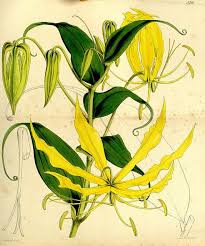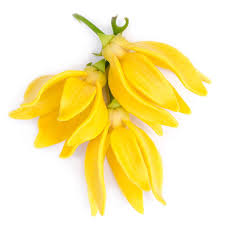In the Malayan language, ylang ylang means 'flower of flowers' - and indeed, no tree produces blossoms with a more intensely sweet and flowery fragrance. Ylang ylang (Cananga odorata) is native to south-east Asia, and grows up to 20m tall.

The branches are gracefully arched like the weeping willow, and bear glossy oval-shaped leaves and an abundance of pendulous yellow-green blooms throughout the year.
Where the trees grow women use the flowers to decorate and perfume their hair. In 1866 the French historian Guibourt recorded a Moluccan Island recipe for a pomade (aromatic ointment) called boori-boori, made by macerating ylang ylang flowers in coconut oil. The islanders used this to protect their hair from sea salt as they swam, and to nourish and soften the skin. During the monsoon, they applied it as a body rub to prevent infectious illness and fevers (including malaria). In Indonesia, it is customary to spread ylang ylang flowers on the bed of a couple on their wedding night. The intoxicating perfume is believed to calm the nerves and lessen inhibition.
In Victorian times the essential oil was an ingredient in the famous Macassar hair oil, used by both men and women to promote lustrous growth. Today, ylang ylang is used to create floral-type perfumes. In particular it adds an exotic sweetness to perfumed based on woody and spicy notes.
Blooms Hand-picked
Most ylang ylang oil is produced in Madagascar, Reunion and the Comoro Islands. The flowers develop their fragrance two or three weeks after the buds open. The mature blooms are gathered by hand in the early morning, when the essential oil is most concentrated. As soon as possible after collecting them, the flowers are processed by steam distillation, using equipment set up for the purpose among the trees.
In terms of fragrance quality, there are several grades of the essential oil. Ylang ylang extra (sometimes labelled 'superior'), and yloang ylang 1,2 and 3. The extra grade is collected from the first distillation; the plant material is distilled two or three times more to obtain the other 'fractions'/ There is also a ylang ylang complete, comprising the total, unseparated oil which is collected after a long process of distillation.
Cananga oil, from a related tree, is sometimes sold as genuine ylang ylang, but it has a relatively harsh aroma with little tenacity. Canange oil, along with the inferior forms of ylang ylang, is used as a fragrance material in the manufacture of soaps and detergents.
Intense and Therapeutic

Aromatherapists favour the more expensive ylang ylang extra or complete grades. Both oils are virtually colourless, with an intense, floral-balsamic fragrance reminiscent of almonds and jasmine. A good quality oil also has a spicy undertone.
Surprisingly, ylang ylang complete has a lighter fragrance, although it is equally tenacious. Ylang ylang is generally perceived as a warming, intoxicating - and reputedly aphrodisiac - oil. Yet the sensual quality is inseparable from ylang ylang's ability to relax and uplift, and instil a sense of wellbeing.
At the turn of the century, two French chemists discovered that ylang ylang was effective against malaria, typhus and other fevers. It was also found to have a regulatory effect on a weak heart action, and a calming effect on the central nervous system.
Certainly, ylang ylang is a wonderful oil for soothing nervous tension, restlessness and irritability. A few drops added to the bath, or diluted as a massage oil, can promote sound sleep. Ylang ylang has a reputation for treating and preventing stress-related high blood pressure, palpitations and rapid breathing. It is also useful for premenstrual tension and depression.
Consultant psychiatrist Dr Tim Betts, at the Queen Elizabeth Psychiatric Hospital in Birmingham, has discovered that ylang ylang can effectively control certain forms of epilepsy, especially when inhaled before the onset of a seizure. 'The oil may contain a pharmacological agent,as yet unidentified, which reduces seizure activity.'